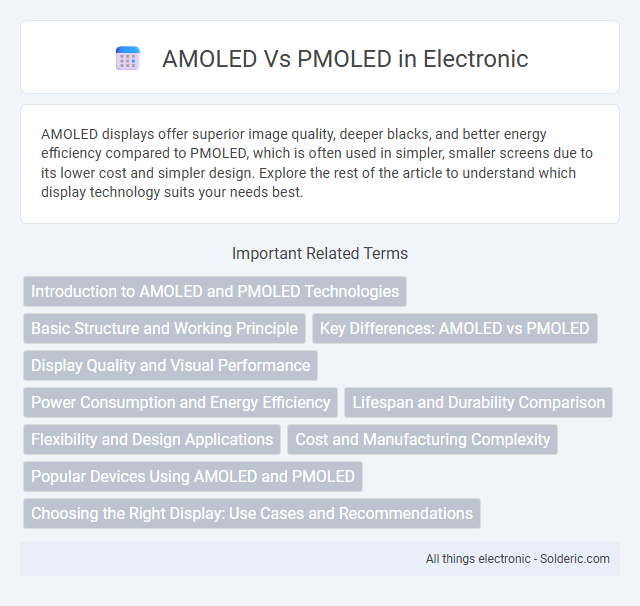AMOLED displays offer superior image quality, deeper blacks, and better energy efficiency compared to PMOLED, which is often used in simpler, smaller screens due to its lower cost and simpler design. Explore the rest of the article to understand which display technology suits your needs best.
Comparison Table
| Feature | AMOLED (Active Matrix OLED) | PMOLED (Passive Matrix OLED) |
|---|---|---|
| Display Technology | Active matrix driving with thin-film transistors (TFT) | Passive matrix driving without TFT |
| Resolution | High resolution, suitable for HD displays | Lower resolution, limited by row scanning speed |
| Power Consumption | More power-efficient for large, high-res screens | Higher power use on larger displays |
| Size | Large and flexible displays possible | Small screen sizes preferred |
| Cost | Higher production cost | Lower production cost |
| Brightness & Contrast | Higher brightness and better contrast ratios | Lower brightness and limited contrast |
| Applications | Smartphones, TVs, wearables, high-end devices | Simple displays, small gadgets, MP3 players |
| Lifetime | Longer lifespan due to controlled pixel driving | Shorter lifespan, prone to burn-in |
Introduction to AMOLED and PMOLED Technologies
AMOLED (Active Matrix Organic Light Emitting Diode) and PMOLED (Passive Matrix Organic Light Emitting Diode) represent two distinct OLED display technologies with unique architectures. AMOLED features an active matrix of thin-film transistors that control individual pixels for higher resolution and faster refresh rates, making it suitable for smartphones and high-end devices. PMOLED uses a simpler passive matrix addressing scheme, resulting in lower cost but limited lifespan and resolution, generally applied in small-sized displays like wearable devices and simple screens.
Basic Structure and Working Principle
AMOLED (Active Matrix Organic Light Emitting Diode) displays utilize a thin-film transistor (TFT) backplane to individually control each pixel's light emission, enabling higher resolution and faster refresh rates. PMOLED (Passive Matrix OLED) relies on a simpler grid of anodes and cathodes where pixels are lit by sequential row and column scanning, resulting in lower resolution and slower response time. The active matrix structure in AMOLED provides improved brightness and energy efficiency compared to the passive scanning mechanism of PMOLED.
Key Differences: AMOLED vs PMOLED
AMOLED (Active Matrix Organic Light Emitting Diode) features a thin-film transistor (TFT) array that actively controls each pixel, enabling higher resolution, faster refresh rates, and better energy efficiency compared to PMOLED (Passive Matrix OLED), which uses a simpler control scheme by scanning row and column lines. AMOLED displays support larger screen sizes and are preferred in smartphones and high-end gadgets due to their superior brightness, color accuracy, and flexibility. In contrast, PMOLED is mainly suited for smaller, low-cost devices like fitness bands and simple displays, offering reduced manufacturing complexity but limited lifespan and brightness.
Display Quality and Visual Performance
AMOLED displays offer superior display quality with higher contrast ratios, deeper blacks, and vibrant colors due to their self-emissive nature, resulting in better visual performance compared to PMOLED screens. PMOLEDs generally have lower resolution and brightness, leading to less sharp images and reduced visibility in bright environments. The flexible design and faster refresh rates of AMOLED panels further enhance smooth motion rendering and overall viewing experience.
Power Consumption and Energy Efficiency
AMOLED displays exhibit lower power consumption and higher energy efficiency compared to PMOLED due to their ability to turn off individual pixels, resulting in true blacks and reduced energy usage. PMOLED panels consume more power as their entire display is refreshed sequentially, regardless of the pixel color, leading to higher energy waste. AMOLED technology is particularly advantageous for battery-powered devices aiming for extended battery life and reduced energy costs.
Lifespan and Durability Comparison
AMOLED displays generally offer longer lifespan and superior durability compared to PMOLED due to their active matrix technology, which reduces power consumption and heat generation. The organic materials in AMOLED panels are less prone to burn-in and degradation, extending the screen's overall reliability. When choosing a display for your device, consider AMOLED for enhanced longevity and consistent performance under prolonged use.
Flexibility and Design Applications
AMOLED displays offer superior flexibility compared to PMOLED, enabling curved and foldable screen designs ideal for smartphones, wearables, and automotive dashboards. PMOLED screens are typically rigid and better suited for compact, simple devices like fitness trackers and small industrial displays. The flexible substrate of AMOLED technology supports innovative, lightweight applications with better durability and enhanced aesthetics.
Cost and Manufacturing Complexity
AMOLED displays are more expensive and complex to manufacture due to their intricate thin-film transistor (TFT) backplane technology and the requirement for precise encapsulation to prevent OLED degradation. PMOLED screens have a simpler structure with fewer control circuits, resulting in lower production costs and easier manufacturing processes but limited size and resolution compared to AMOLED. The higher cost of AMOLED is justified by superior display quality and flexibility, while PMOLED remains cost-effective for small, low-resolution applications.
Popular Devices Using AMOLED and PMOLED
Smartphones like Samsung Galaxy S series and OnePlus utilize AMOLED displays for vibrant colors and energy efficiency. PMOLED panels are commonly found in small devices such as fitness trackers and basic MP3 players, including older iPod models. AMOLED's superior performance in high-resolution screens makes it the preferred choice for flagship smartphones and wearables.
Choosing the Right Display: Use Cases and Recommendations
AMOLED displays offer superior color accuracy, faster refresh rates, and better power efficiency, making them ideal for smartphones, high-end wearables, and devices requiring vibrant visuals and prolonged battery life. PMOLED screens, being simpler and cost-effective, are best suited for small-sized displays with static or limited graphical content, such as fitness trackers and basic portable gadgets. Choosing the right display depends on prioritizing either advanced visual performance and energy-saving properties (AMOLED) or budget-friendly simplicity and ease of integration (PMOLED).
AMOLED vs PMOLED Infographic

 solderic.com
solderic.com